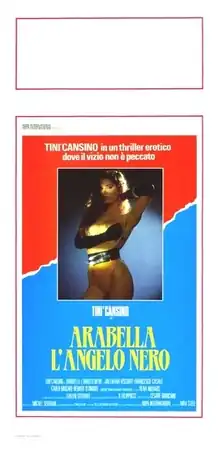Arabella Black Angel
Arabella Black Angel (Italian: Arabella l'angelo nero, lit. 'Arabella the Black Angel') is a 1989 Italian film directed by Stelvio Massi. The film stars Tinì Cansino as an unsatisfied married woman who lives a double life as a sex worker. She finds herself the main suspect in a series of murders and attempts to find the real killer.
| Arabella Black Angel | |
|---|---|
 | |
| Directed by | Stelvio Massi |
| Screenplay by | R. Filippucci[1] |
| Story by | R. Filippucci[1] |
| Starring |
|
| Cinematography | Stefano Catalano[1] |
| Edited by | Cesare Bianchini[1] |
| Music by | Serfran[1] |
Production company | Arpa International S.r.l.[1] |
Release date |
|
| Country | Italy[1] |
| Language | Italian[2] |
Cast
Cast adapted from Blood & Black Lace.[1]
- Tinì Cansino as Arabella/Deborah Veronesi
- Valentina Visconti as Gena Fowler
- Francesco Casale as Francesco J. Veronesi
- Carlo Mucari as De Rosa
- Renato D'Amore as Scognamillo
- Ida Galli as Martha Veronesi
Production
Stelvio Massi was working on post-production on the film Taxi Killer when the producer announced the film had gone bankrupt, leading the film to be shelved. Massi moved on to direct Arabella Black Angel under the name of "Max Steel".[3]
The film stars Tinì Cansino, who was best known in Italy for her appearances on the television series Drive In.[3]
Release
Arabella Black Angel was released in 1989.[3][4] It was released by Penthouse Video in Japan under the English title of Black Angel with an 88-minute running time.[1] Vinegar Syndrome released the film as Arabella Black Angel as part of their Forgotten Gialli: Volume Four box set along with The Killer is Still Among Us and The Sister of Ursula.[2]
Reception
From retrospective reviews, critic and film historian Roberto Curti found the film to be derivative of Ken Russel's Crimes of Passion (1984) and finding it bared no trace of the visual flair Massi had showcased in the past. Curti also found Cansino's acting weak when performing the more sexual scenes in the film.[3] Adrian Luther Smith in his book Blood & Black Lace also noted that Massi "seems happy to wade around in the script's sex and violence" while finding Cansino to be what weakens the film, referring to her as an "unassured actress."[1]
See also
References
- Luther Smith 1999, p. 8.
- "Forgotten Gialli: Volume Four". Vinegar Syndrome. Retrieved March 11, 2023.
- Curti 2022, p. 391.
- Curti 2022, p. 9.